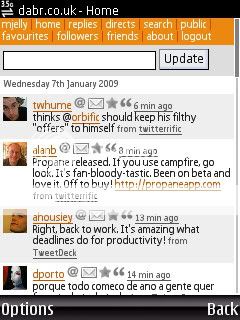Dabr - mjelly mobile 2.0 service of the week
Happy New Year! It’s James from mjelly here with the first “Mobile 2.0 Service of the Week” of 2009. If 2008 was “The Year of Mobile” then 2009 is “The Year of Mobile 2.0” and we’ll be tracking it all here at Mobile Industry Review.
To start the year with a bang this week’s featured mobile 2.0 service is dabr.co.uk.
What is it?
Dabr is a mobile web interface to
twitter – the micro-blogging and social networking service of the moment, and is built on the twitter API. It provides a range of features that the standard
m.twitter.com mobile site does not for example:
– the ability to “retweet” (i.e. quote other people’s twitter messages)
– support for in-line twitpics
– profile pictures
– search
– follow and unfollow (believe it or not m.twitter.com doesn’t let you do this!)
– view followers
Unlike other similar services like m.slandr.net the dabr is completely free of advertising. Dabr is based on open source code developed as a personal project by David Carrington, a Maidenhead-based web developer. David built the first version of the site in just over a week and has been continuing to develop it since then.
Why is it interesting?
Dabr has built up a large and passionate following with people like Mobile Industry Review’s own Whatleydude
championing it and bigging it up on twitter. As a result, the traffic is growing at a pretty hefty rate with a 150% increase in page views between October and December 2008.
Dabr is also an example of the power that APIs can bring to the world of mobile. To date, APIs and developer networks have mainly been largely confined to the world of PC’s and web 2.0. Until now, mobile hasn’t really begun to exploit the advantages of this kind of open approach to data and services.
One of the issues for web players moving onto mobile is that mobile extensions require extra resource, particularly if multiple versions are need e.g. a mobile web site and Symbian/ Android/ iphone/applications to cover all the different device types.
What dabr shows it that by offering an API, web players can push the development effort required to build mobile versions to external developers and third parties. Twitter has really benefited in this area with developers creating a whole raft of different mobile twitter services including
iphone twitter apps, Blackberry twitter apps and more.
This is also happening in the case of Friendfeed (the creator of gmail’s latest startup) where an external developer used their API to build FFtogo.com, a
href=”http://mjelly.com/site/3454-Friendfeed”>Friendfeed mobile site – before even Friendfeed had managed to build their own in-house mobile version!
Another point worth making is that the mobile network operators have been very slow to develop API’s that could allow services to be built more easily, for example, to pass information on subscribers to allow more targeted advertising, or providing easy access to location feeds. What dabr shows is that APIs can really bring a lot to the table in terms of developing the mobile web ecosystem and need to be rolled out much more rapidly and widely.
You can find dabr on mjelly, which is a directory of the
best mobile sites and other stuff





